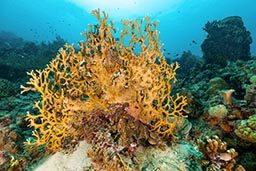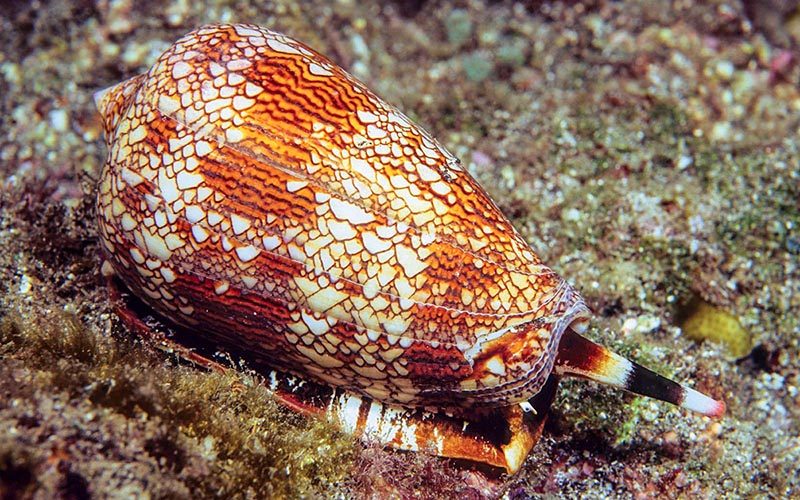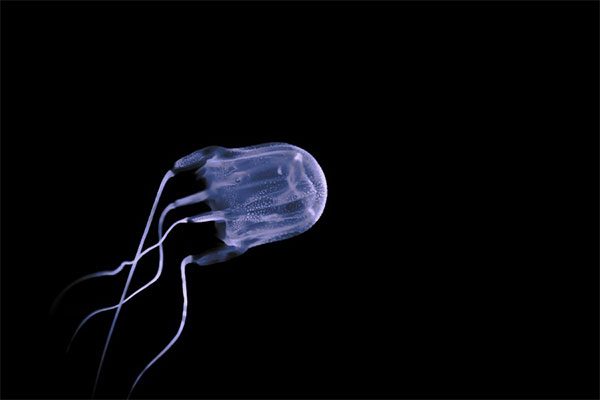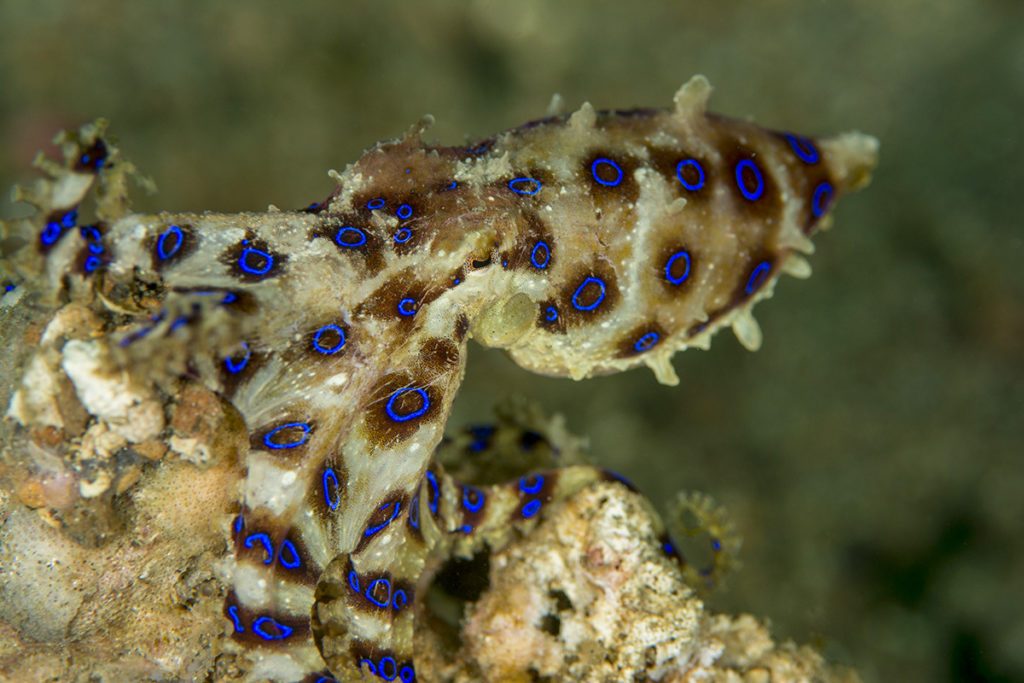Hazardous Marine Invertebrates
Sharks have a bad reputation for being the most dangerous creatures in the ocean, but injuries from invertebrates are far more common. While fire coral, cone snails and some species of jellyfish don’t look dangerous, they can cause some serious harm.
What follows is an overview of some of the ocean’s most hazardous invertebrates and an abbreviated summary of first aid treatments. This article is not a comprehensive guide, nor is it a substitute for proper education. Divers Alert Network® (DAN®) encourages all divers to contact a DAN Instructor to learn more about first aid training for hazardous marine life injuries.
Fire Coral
Locations found: Atlantic, Indian and Pacific Oceans; Caribbean Sea

Divers who disregard the guideline “look but never touch” are likely to feel the sting of fire coral, which can be found all over the world’s most popular scuba diving destinations. When touched or even brushed against with bare skin, fire coral can cause a burning sensation that may last for several hours. Exposure to fire coral can also cause a skin rash that may last up to a week.
The best way to avoid being “burned” by fire coral is to maintain good buoyancy and avoid touching coral heads, rocks or shells where fire coral can live.
It is also wise to avoid touching any part of a wreck or a mooring line with bare hands. Divers concerned about accidental encounters may choose to wear a full body-wetsuit, boots and gloves.
First aid treatment for fire coral includes:
- Rinse the affected area with household vinegar.
- Keep the area clean, dry and aerated — time will do the rest.
- For open wounds, seek medical evaluation.
- Antibiotics or a tetanus booster may be recommended by a physician.
Cone Snails
Locations found: Indian and Pacific Ocean
Cone snails live in shallow reefs primarily in tropical and sub-tropical waters, though some have adapted to colder temperatures. These snails dwell inside beautiful cone-shaped shells, but do not let their beauty distract you: cone snails have a venomous, harpoon-like tooth they use to inject venom into prey or a perceived attacker.
If bitten, a victim may experience pain, swelling and in severe cases paralysis, respiratory failure and death. While not every species of cone snail is deadly, every species of cone snail is venomous, which is reason enough for divers to continue following the, “take only pictures, leave only bubbles,” bit of wisdom.

Cone snail antivenom does not exist, but in the event of an envenomation, seek immediate medical attention even if the victim does not report any pain or show signs of paralysis. Clean the wound and apply the pressure immobilization technique after contacting emergency medical services (EMS).
Remember that not every cone snail bite is fatal and mortality rates depend upon the amount of venom injected, the victim’s size and susceptibility and the species of cone snail among other factors.
Box Jellyfish
Locations found: Northern Australia; Indian and Pacific Oceans
The box jellyfish, also known as a sea wasp, is one of the most dangerous creatures in the ocean. The venom from certain species is potent enough to kill a human within three minutes.
Box jellyfish have a cube-shaped medusa and nearly-invisible tentacles that can extend up to 16 feet (5 meters). To avoid jellyfish stings, wear a full wetsuit, hood, boots and gloves, but most importantly: do not dive in areas that box jellyfish are known to inhabit. In Northern Queensland, Australia, net barricades are set up to protect swimmers at nearby beaches in areas where box jellyfish congregate in summer months (November to May). While the nets do not guarantee safety, they do minimize the risk of encounter.

Box jellyfish stings require immediate medical attention. Venom from certain species can induce Irukandji syndrome, a condition defined by severe pain, nausea, vomiting, sweating, anxiety, hypertension, tachycardia and pulmonary edema. In some cases, people with Irukandji syndrome experience a feeling of impending doom, and in rare cases go into cardiac arrest, requiring immediate CPR.
For jellyfish stings in general, first aid treatments include:
- Generously pouring or spraying household vinegar on the affected area for at least 30 seconds and allowing the vinegar to stand for a few minutes before doing anything else. Avoid rubbing the area as this can increase envenomation.
NOTE: Vinegar neutralizes any remaining, unfired nematocysts on the diver’s skin. It will not reduce pain or affect the venom that has already been injected. - Washing the area with seawater (or saline) using a syringe with a steady stream of water to help remove any tentacle remains. Do not rub.
NOTE: Do not use freshwater; this could cause massive nematocyst discharge
Applying heat up to 113°F/45°C for 30 to 90 minutes. If a temperature gauge is not available, test the water temperature on yourself first (the victim may be in too much pain to evaluate whether the water is too hot). Test the water on the same area of your body where the diver was injured and use the hottest water you can tolerate without scalding.
NOTE: Application of heat has two purposes: 1) it may mask the perception of pain; and 2) it may assist in thermolysis. Since we know the venom is a protein that has been superficially inoculated, application of heat may help by denaturing the toxin. - Always seek emergency medical evaluation.
Sea Urchins
Locations found: All oceans

Sea urchin injuries are one of the most common marine life injuries reported to DAN. Urchins live in oceans across the world, and their pointy spines can easily penetrate a dive boot or wetsuit. Divers can avoid sea urchin injuries by paying attention to where they step, especially on rocky shores. As with all marine life, sea urchins should never be touched or picked up.
Sea urchin spines are hollow and relatively fragile. Once they poke through a dive boot or wetsuit, they are likely to break off.
First aid treatment is situational, but may include:
- Applying heat for 30-90 minutes (test the temperature on yourself before applying to the victim)
- Removing superficial spines – try using bare fingers before using tweezers to remove the fragile spines Do not attempt to remove spines embedded in the skin. Deeply embedded spines may break down into smaller pieces, complicating the removal process.
- Washing the affected area thoroughly, but do not rub or scrub
- Applying antiseptic
- Do not close the wound with tape or glue, as this may increase the risk of infection.
Regardless of any first aid provided, always seek a professional medical evaluation. Deep puncture wounds have the potential for serious infections, including tetanus.
Blue-Ringed Octopus
Locations found: Indian and Eastern Pacific Ocean

The blue-ringed octopus lives in tropical tide pools from southern Japan, to Australia, to the western Indo-Pacific. Its potent venom can cause paralysis, respiratory failure and even death within minutes.
This small octopus is not aggressive, and divers can protect themselves by refraining from sticking their hands or other objects into holes where the octopus may be hiding, and not picking up bottles, cans or shells. As with all marine animals, divers should not attempt to touch or handle the blue-ringed octopus.
A blue-ringed octopus bite is usually painless, or at worst, similar to a bee sting; however, even painless bites should be taken seriously as no antivenom is available. Contact EMS without delay in the event of a bite and be sure to clean the wound with freshwater and apply the pressure immobilization technique. While waiting for EMS, be prepared to provide ventilations if paralysis sets in.
Injuries from invertebrates are, for the most part, avoidable, but accidents do happen. To learn how to prevent and respond to marine life injuries, contact a DAN Instructor about the Hazardous Marine Life Injuries course. The class covers first aid for common marine life injuries from sponges, bristleworms, vertebrates and other animals not mentioned in the article above.